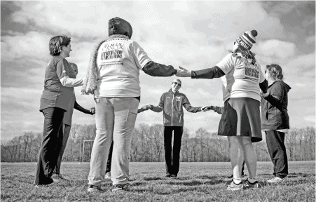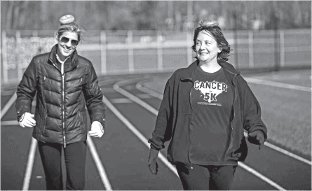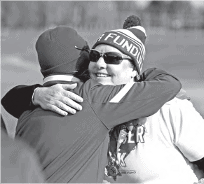The Ulman Cancer Fund encourages a return to fitness
Amanda Loudin
March 2017/April 2017
In 2012, at the age of 39, Christina Miller was a busy mom wrangling three small children when she discovered a lump in her breast. Diagnosed with stage three cancer, she faced a double mastectomy, 20 weeks of chemotherapy and five weeks of radiation.  It was during one of those rounds of chemo that she learned about a program that would change her life.
It was during one of those rounds of chemo that she learned about a program that would change her life.
“I was in the hospital and saw a nurse who knew me from all of my children’s births,” she says. “She told me about the Ulman Fund’s Cancer to 5K program. At the time, it was more than I was ready for, but I kept the information in a folder.”
A few months later, Miller felt the need to “get out of my head and live a little,” she says. “I’d been a runner before and joining a program to help me get back to that seemed like a good idea.”
Since Ulman’s Cancer to 5K started in 2007, more than 200 cancer survivors have joined the free, 12-week program, which is designed to reintroduce them to physical activity, eventually competing in a road race. Coaches and team “sherpas” lead the group, which meets locally twice a week and culminates with a nearby 5K. Sessions take place either once or twice each year, typically in the spring and fall. Sherpas are volunteers who pace and support runners during training and races.
Today, Miller is not only a graduate of the program, but is also the Ulman Fund’s senior program manager of patient navigation. “When I joined the program, I realized I didn’t have to go it alone,” she says. After two seasons participating as a survivor, Miller joined the team as a sherpa. “I became even more invested in the program’s mission,” she says, and that led to her current position.
Survivor and participant Melanie Lerner, a 55-year-old consultant from Highland, says she has benefitted from the program both  emotionally and physically. “The whole group is there for me,” she says. “They’re so supportive and even when we’re not training, we stay in touch, sometimes meeting to walk together.”
emotionally and physically. “The whole group is there for me,” she says. “They’re so supportive and even when we’re not training, we stay in touch, sometimes meeting to walk together.”
Coach Janelle McIntyre of Ellicott City has been with the program for five years. She initially became involved to show support for a friend suffering from ovarian cancer. Other friends joined as sherpa helpers, and McIntyre eventually became a coach. Initially the group of women joined to maximize the time with their friend, McIntyre explains. “But once you get involved, there’s no leaving,” she says. “The team becomes your family.”
About 10 runners take part in each session. Survivors have ranged in age from 12 to 62 over the years, and most who join the program remain involved on some level, even after they’ve met their goal of completing the 5K race. “You’ll see survivors come back for several sessions,” says McIntyre. “Others move on but stay in touch.”
Lerner is back at it again this spring, gunning to beat her time from 2015. “When I started last year, it was just after finishing up treatments and all I could do was walk,” she says. Now she’s running, and the program gives her something to look forward to. “It has motivated me to keep running over the winter.”
Coach Lisa Fichman of Columbia often draws on stories like Lerner’s, as well as the survivors’ positive attitudes. “The program has given me so much perspective,” she says. “I’ll think of the survivors and what they’ve been through whenever I’m struggling with my own running or racing.”
 Fichman initially volunteered after several years coaching with the Howard County Striders. “I wanted to add another level of meaning to my coaching,” she says. Working with the Ulman Cancer to 5K, she says, “seemed a logical progression.” And, she adds, “It has exceeded my expectations.”
Fichman initially volunteered after several years coaching with the Howard County Striders. “I wanted to add another level of meaning to my coaching,” she says. Working with the Ulman Cancer to 5K, she says, “seemed a logical progression.” And, she adds, “It has exceeded my expectations.”
The coaches and sherpas often go above and beyond expectation. After one of the program members passed away, for instance, the team organized a day of yard work for her family. When survivors need other types of help in order to attend a training session, the team steps in. “When I first joined the program, I was juggling taking care of the kids while completing the training,” says Miller. “The team told me to bring them along and they watched them while I ran.”
McIntyre says that the survivors form a strong emotional bond that goes beyond the physical gains from the training. “They can share their stories in a safe space and that’s therapeutic for them,” she explains.
Miller agrees. “This is so much more than a training program,” she says. “It’s a community.”
THE YOUNGEST SURVIVOR
While the Cancer to 5K program has traditionally served adults, in the spring of 2014, 12-year-old Meghan Erdman shook things up by becoming the youngest survivor in the program. Though Meghan was initially reluctant to join a team of adult survivors, her mother Michele says, now the program is an integral part of the teen’s life.
up by becoming the youngest survivor in the program. Though Meghan was initially reluctant to join a team of adult survivors, her mother Michele says, now the program is an integral part of the teen’s life.
Meghan was diagnosed with Hodgkin’s lymphoma in the fall of 2013, and her parents learned of the program through a brochure they picked up during one of Meghan’s treatments. “We wanted to help her become physically active again,” says Michele. “On her first day with the group, she didn’t want to be there. But everyone was so great that she was ready to go back for the next session.”
The program not only helped Meghan regain physical strength, but it taught her she wasn’t alone. “She found others in the same boat and that really helped her,” says Michele. “They can talk about what they’re going through and relate to each other.”
Since joining the group, Meghan has gone on to become a team sherpa and help other survivors, even as her own fight with cancer continues. “She will share her story with anyone who needs to hear it,” says Michele. “The program will always be a part of her life.”




